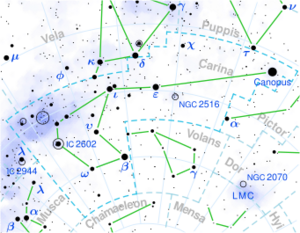Astronomy:HD 95109
From HandWiki
Short description: Star in the constellation Carina
| Observation data Equinox J2000.0]] (ICRS) | |
|---|---|
| Constellation | Carina |
| Right ascension | 10h 57m 48.18690s[1] |
| Declination | −59° 43′ 55.8872″[1] |
| Apparent magnitude (V) | 5.72 - 6.90[2] |
| Characteristics | |
| Spectral type | F6-G7 Iab[2] |
| Variable type | δ Cep[2] |
| Astrometry | |
| Proper motion (μ) | RA: −5.73[1] mas/yr Dec.: 1.89[1] mas/yr |
| Parallax (π) | 0.21 ± 0.56[1] mas |
| Distance | 1,401[3] pc |
| Absolute magnitude (MV) | −5.27[3] |
| Details | |
| Mass | 7.5 - 11.7[4] M☉ |
| Radius | 140.7[3] R☉ |
| Luminosity | 15,000[5] L☉ |
| Surface gravity (log g) | 1.2[6] cgs |
| Temperature | 5,980[6] K |
| Metallicity | +0.01[7] |
| Age | 29[7] Myr |
| Other designations | |
| Database references | |
| SIMBAD | data |
HD 95109 (U Carinae) is a Classical Cepheid variable, a type of variable star, in the constellation Carina. Its apparent magnitude is 6.86.

U Car is a δ Cepheid variable with a period of 38.7681 days. It was one of the earliest Cepheids to be discovered. It has also one of the longest periods, and hence is one of the most luminous in the class.[9] There are still only a few Cepheids with longer periods, including RS Puppis, SV Vulpeculae, and the unusual S Vulpeculae.[2]
The brightness variation in U Car is caused by fundamental mode pulsations. The radius and temperature both vary, with the radius changing by 42 R☉ during each cycle.[10] The temperature variation causes the spectral type to vary between F6 and G7.
References
- ↑ 1.0 1.1 1.2 1.3 1.4 Van Leeuwen, F. (2007). "Validation of the new Hipparcos reduction". Astronomy and Astrophysics 474 (2): 653–664. doi:10.1051/0004-6361:20078357. Bibcode: 2007A&A...474..653V.
- ↑ 2.0 2.1 2.2 2.3 Samus, N. N. et al. (2009). "VizieR Online Data Catalog: General Catalogue of Variable Stars (Samus+ 2007-2013)". VizieR On-line Data Catalog: B/GCVS. Originally Published in: 2009yCat....102025S 1. Bibcode: 2009yCat....102025S.
- ↑ 3.0 3.1 3.2 Groenewegen, M. A. T. (2013). "Baade-Wesselink distances to Galactic and Magellanic Cloud Cepheids and the effect of metallicity". Astronomy & Astrophysics 550: A70. doi:10.1051/0004-6361/201220446. Bibcode: 2013A&A...550A..70G.
- ↑ Caputo, F.; Bono, G.; Fiorentino, G.; Marconi, M.; Musella, I. (2005). "Pulsation and Evolutionary Masses of Classical Cepheids. I. Milky Way Variables". The Astrophysical Journal 629 (2): 1021–1033. doi:10.1086/431641. Bibcode: 2005ApJ...629.1021C.
- ↑ Tsvetkov, Ts. G. (1985). "Population I pulsating stars. I - Period-luminosity (-colour) relations". Astrophysics and Space Science 117 (2): 227. doi:10.1007/BF00650149. Bibcode: 1985Ap&SS.117..227T.
- ↑ 6.0 6.1 Romaniello, M.; Primas, F.; Mottini, M.; Pedicelli, S.; Lemasle, B.; Bono, G.; François, P.; Groenewegen, M. A. T. et al. (2008). "The influence of chemical composition on the properties of Cepheid stars. II. The iron content". Astronomy and Astrophysics 488 (2): 731. doi:10.1051/0004-6361:20065661. Bibcode: 2008A&A...488..731R.
- ↑ 7.0 7.1 Marsakov, V. A.; Koval', V. V.; Kovtyukh, V. V.; Mishenina, T. V. (2013). "Properties of the population of classical Cepheids in the Galaxy". Astronomy Letters 39 (12): 851. doi:10.1134/S1063773713120050. Bibcode: 2013AstL...39..851M.
- ↑ Laney, C. D.; Stobie, R. S. (April 1992). "JHKL Observations of Galactic Cepheids". Astronomy & Astrophysics Supplement Series 93: 93–120. Bibcode: 1992A&AS...93...93L. https://ui.adsabs.harvard.edu/abs/1992A&AS...93...93L. Retrieved 20 November 2021.
- ↑ Shapley, H. (1918). "Studies based on the colors and magnitudes in stellar clusters. VIII. The luminosities and distances of 139 Cepheid variables". Astrophysical Journal 48: 279. doi:10.1086/142435. Bibcode: 1918ApJ....48..279S.
- ↑ Laney, C. D.; Stobie, R. S. (1995). "The radii of Galactic Cepheids". Monthly Notices of the Royal Astronomical Society 274 (2): 337. doi:10.1093/mnras/274.2.337. Bibcode: 1995MNRAS.274..337L.
 |


